Managing House Price Booms: The Role of Macroprudential Policies, Remarks at the IIM-Bangalore and IMF Conference on Housing Markets, Financial Stability and Growth, By Ratna Sahay, Deputy Director, Monetary and Capital Markets Department, IMF
December 10, 2014
Financial Stability and Growth
Ratna Sahay, Deputy Director
Monetary and Capital Markets Department, IMF
December 11-12, 2014
As prepared for delivery
1. On behalf of the IMF, let me begin by expressing my gratitude to the IIM-Bangalore for organizing this conference with us and for being such wonderful hosts. This is the third conference on housing issues that we have organized over the past year in partnership with leading institutions around the world. The focus of those first two conferences was more on housing issues in advanced economies; with this conference we are moving closer to the scene of much of the action at present, namely the emerging market economies.
2. I will cover three areas in my remarks:
- the state of global housing markets;
- the policy framework to manage house price booms;
- the role of macroprudential policies.
3. Before delving into the details, let me outline the broad contours of my talk:
- The global housing market is characterized by a two-speed recovery, with a strong rebound in house prices in many countries but a much weaker recovery in others. Policies have to be very alert to this difference. There are countries where housing markets, and often the overall economy, have not fully shrugged off the effects of the global financial crisis. In these countries, the first order of business clearly is to close output gaps and to nurture the housing sector back to health.
- Much of what I have to say today applies at present to economies where housing markets are booming and private sector leverage is high. In such situations there can be an important role for macroprudential policies as part of the policy framework to create buffers and curb leverage to ensure that shocks from the housing sector do not spill over and threaten economic and financial stability.
- The bulk of my talk will be devoted to discussing what we know—and are learning—about how to make macroprudential policies more effective. In discussing the role of these policies I will be drawing extensively on work done at the IMF recently, including a note about to be issued to our staff to guide the advice they provide countries on macroprudential policies.
4. Let me now get into the details, starting with an update of global housing markets.
A. State of Global Housing Markets: Two-Speed Recovery
5. The IMF’s Global House Price Index—an average of house prices in 50 countries—shows only a modest uptick over the past few years (IMF Global Housing Watch). So on the surface things look calm. But concealed within the benign average is a two-speed recovery. Figure 1 shows the real house price indices for two groups of countries. The 33 economies in the ‘recovering’ group experienced a sharp boom in house prices before the global financial crisis, a sharp fall during the crisis, and have had an anemic recovery since then. The 17 economies in the ‘rebounding’ group, in contrast, after a shorter bust during the crisis, seem headed for a new round of house price booms. The chart also shows that there has been a two speed recovery not just for house prices but for bank credit.
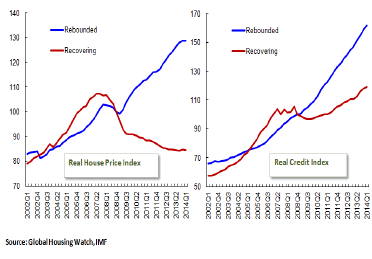
6. Why should we worry about these developments? A couple of reasons:
- First, twin booms in house prices and credit often do not end well. In the past such twin booms have been accompanied by either a financial crisis or poor economic performance in 90 percent of the cases studied by a team of IMF researchers (Crowe et al, 2011). This is much higher than the outcome of real estate booms by itself.
- Analysis has also shown that financial cycles and business cycles interact (Claessens et al, 2012). Recessions with house price busts lasts about 1.5 quarters longer than those without house price busts, and importantly, entail more than 7 percent drop in the level of real GDP. What is more, recoveries with house price booms are short-lived.
In short, historically, twin booms have endangered economic growth and financial stability. History does not always repeat itself; but we would be sorry if it did and we were not prepared.
7. So the question is: how can we prepare? That leads me to the policy framework to manage house price booms.
B. The Policy Framework: the Trinity
8. Experience from the Global Financial Crisis has exposed a gap in financial stability policy: as the Chair of the US Federal Reserve, Janet Yellen recently acknowledged: “…monetary policy faces significant limitations as a tool to promote financial stability” (Yellen, 2014). The framework that I will describe seeks to overcome this limitation by employing a broader set of policies to help reduce the likelihood and the severity of financial busts (Figure 2). Avinash Dixit suggested a clever way to remember this set of policies: he called it ‘MiP, MaP, MoP’, referring to microprudential policies, macroprudential policies and monetary policy, respectively.
- Microprudential policies are aimed at ensuring the good health of individual financial institutions and contribute to a stable financial system. This is in the interest ultimately of depositors and those who have claims on financial institutions (including banks, insurance companies and pension funds).
- Macroprudential policies are intended to ensure the good health of the financial system as a whole. In particular, they are intended to limit systemic risk—this is the risk of disruptions to the provision of financial services due to impairment of all or parts of the financial system, which can have serious adverse consequences for the whole economy.
- Monetary policy, of course, is the use of policy interest rates and other levers to keep inflation close to (an implicit or explicit) target and output close to potential.
So this is the policy trinity. Each policy has to do its own job well but also complement the others. This is not an easy task as there are difficult trade-offs.
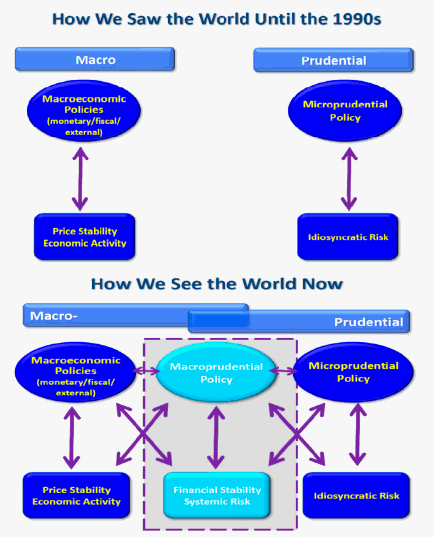
9. MaP interacts with many other policies and can lead to complementarities and difficult trade-offs (Figure 3). Apart from fiscal, structural, competition, and crisis management policies, house price booms could also be driven by supply constraints such as tight land regulations and the geographical nature that hinders expansions on residential constructions. Recent Fund research shows that easing such restrictions could help dampen credit-fuelled housing booms.
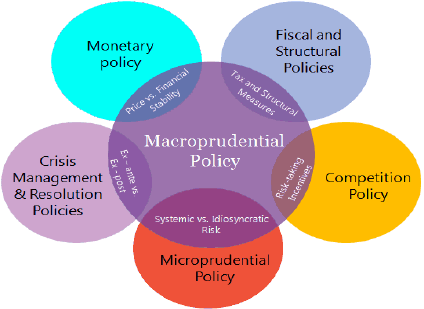
Source: IMF, 2013.
10. The issue of policy trade-offs is particularly true of the interaction between macroprudential and monetary policies. One can illustrate this point by looking at where countries are at the moment, using a scatter diagram of the economic gap and financial gap. Figure 4 shows whether countries that have economic slack (such as with low or negative output gaps and inflation lower than target) also have weak financial cycles (such as with credit/GDP ratio lower than historical trend and real house prices lower than historical trend).
- Most countries are in the south-west quadrant. This means that continuing on accommodative monetary policies would help on both the economic and financial fronts. In the other direction—in the North-East quadrant—Brazil, Turkey and Indonesia have both economic and financial overheating, requiring tighter policies. So in both these cases, there is no conflict in monetary and macroprudential goals.
- There is a group of advanced and emerging economies though that does face a trade-off: Figure 4 shows the cases of Canada, Chile, Japan, Sweden, Switzerland, and Thailand. There is some economic slack but financial overheating at the same time. In these cases, a tightening of macroprudential policies is warranted but there is risk of adding to the economic slack when those policies have sizable effects on aggregate demand. Or, if monetary policies stay very accommodative, the low interest rates could make the private sector more leveraged and stoke further the financial cycle. In this case, targeted macroprudential policies in specific segments of the housing and credit markets may be appropriate if monetary policy remains accommodative.
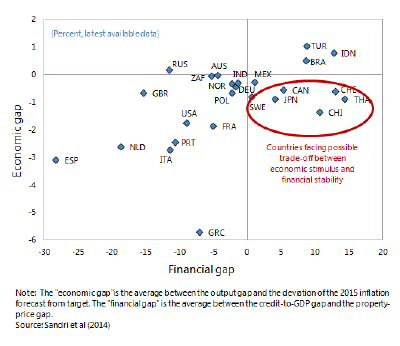
15. The task is made more difficult when a number of agencies are involved. A survey by the IMF found that in a majority of the countries, multiple agencies share the macroprudential mandate, with the central bank as one of the members of a coordination body (Figure 5). Moreover, as a rule, the central bank participates in the arrangements, even if it does not always assume the central role. IMF research does show that policy response time is shorter when central bank involvement is greater. This is because the central bank can coordinate well interactions with other policies such as MoP and MiP This points to the benefit of assigning an important role to the central bank that can harness its independent expertise in assessing financial conditions. While there are a number of ways to assess whether a particular set up is effective, no one structure is perfect or the right one for all.
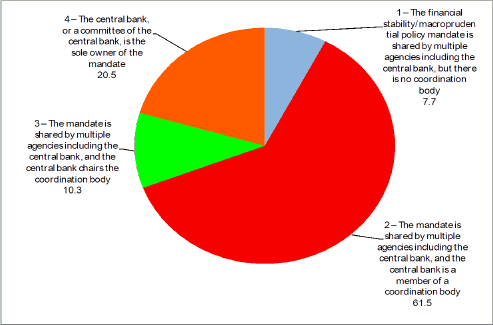
Source: Lim et al, 2013.
16. Microprudential supervision should work hand in glove with macroprudential policies. Indeed the countercyclical capital buffer in Basel III is guided by the need for a macroprudential perspective in financial regulation. When the financial gap opens up, the countercyclical capital buffer is triggered such that banks start building up these buffers; the aim is to release these buffers when there is risk of a credit crunch that could adversely affect financial stability. Nevertheless, a tug of war between the two sides could arise. This is especially in bad times, when macroprudential policies need to be relaxed while microprudential policies require tightening of capital and liquidity requirements. Having sufficient buffers built in advance reduces such tensions.
17. Let me now turn to discussing macroprudential policies, which have a central role in the ‘MiP, MaP, MoP’ policy trinity.
C. Macroprudential Policies: Enhancing Effectiveness
18. There are three aspects of the role of macroprudential policies that I am going to cover today.
19. The policy tools that will be employed when needed have be selected in advance. Figure 6 shows that there is a range of tools at the authorities’ disposal. There are the broad-based tools targeted at lenders such as the countercyclical capital buffer that protect the system from overall credit booms and increase the resilience of financial systems. Then there are sectoral tools targeted at households and lenders:
- Limits on loan-to-value (LTV) ratios cap the size of mortgage loan relative to the value of the property associated with the loan.
- Limits on debt-service to income (DSTI) ratios restrict the size of a debt service payment to a fixed share of household income.
- Sectoral capital requirements force lenders to hold extra capital against loans to a specific sector, such as real estate, in the form of higher risk-weights.
- Provisioning requirements force lenders to build reserves against an eventual nonpayment of loans to particular sectors.
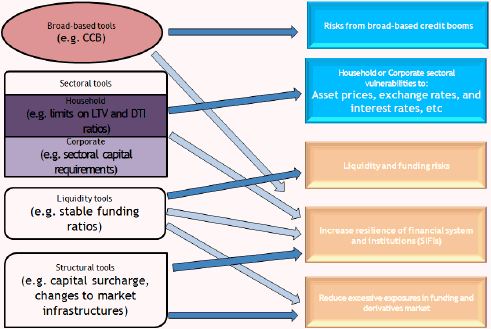
Source: IMF, 2013
The sectoral tools increase the resilience of households to asset price busts (by making them less leveraged) and increase the resilience of financial institutions by making them hold more buffers.
20. Countries already actively use these tools, especially in emerging economies. In Figure 7, the top-most chart shows the use of such tools across regions. Many Asian countries are going through twin booms in real estate and credit markets and have tightened macroprudential tools to mitigate risks. The chart in the middle shows the countries that are active users of a popular tool in the housing sector: LTV limits for imposing down payment requirements on borrowers. And the bottom panel shows the range of these LTV limits. There is no magic number for these limits. These range from 40 to more than 100, and often differentiate by type of borrower, property, or currency. For instance, the limit for commercial property in Hong Kong SAR can be as low as 40 percent; the limit on unhedged foreign-currency mortgages in Romania is 60 even though local currency mortgages have a limit of 85.
21. What indicators can signal to authorities that they should start to employ or modify these tools? The key is to combine the information from several indicators from various sources. A recent collaboration of Fund staff with six central banks—from Brazil, Korea, Hong Kong SAR, Malaysia, Poland, and Romania—dug deep into country experiences (Jácome and Mitra, forthcoming). We found creative use of micro-level data from financial institutions and credit bureaus along with macro-level indicators of household leverage, indebtedness, house prices and credit concentrations. It is especially important to look at household indebtedness, speculative activities, and qualitative indicators on financial sector risk-taking. Three trends, apart from fast credit and asset price growth, especially send an alert signal:
- Rapid growth in high-LTV loans with long maturities;
- Rapid growth in mortgage loans and the number of borrowers with multiple mortgages (which could signal speculative activity or circumvention of LTV or DSTI limits); and,
- Increasing non-performing loans (NPLs) on particular loan characteristics, even if the overall NPL-ratio is declining.
22. How can authorities decide how much to tighten? Here too our collaboration with the six central banks can provide some guidance. Let me give you the example of Brazil and Romania, which faced rapid growth in secured loans. They paid very close attention to the nonperforming loans (ratio to total loans) for each decile of LTVs--60, 70, and so on—loan maturities and household income levels. They found that the higher the LTVs, the longer the loan maturity and the lower the income levels, the greater is the difficulty of the loan being repaid. They then translated this information to inform tighter policies on loans with certain characteristics. What I want to emphasize is that in order to understand how much to tighten, you need to go granular.
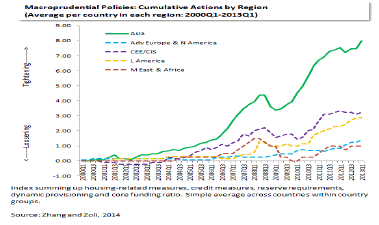
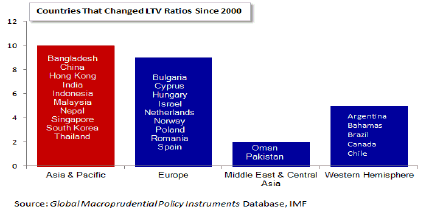
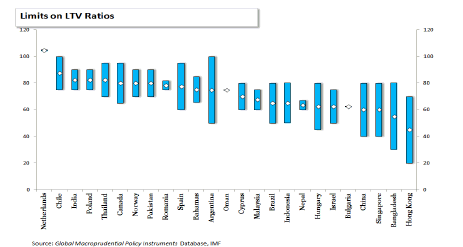
23. Evidence is accumulating on the effectiveness of macroprudential policies. Let’s take the case of the most popular measures: limits on LTV and DSTI. Research by Fund staff, using cross-country panels or macro-level time-series data at the country level, shows that that they are effective on average in curbing both credit growth and house price growth. We are also starting to drill down on country specific cases. Holding our magnifying glass against both macro and micro-level data gives us a more nuanced picture. In most of the six countries I mentioned earlier, the measures helped in lowering credit growth and improving loan-service performances but did not lower house price growth. Measures were less effective when foreign banks made direct cross-border loans to households through local representative offices (such as in Central and Eastern Europe) or when there was a high demand for houses from foreign buyers using cash instead of borrowing from the banking system.. Results were better when, as in Korea, the loan segment most at risk was targeted (rather than aiming at overall mortgages). Dampening house price acceleration seems to require fairly targeted measures. Examples include stamp duties, a fiscal measure, targeting the level of transactions in Hong Kong SAR and LTVs targeting speculative properties and areas in Korea.
24. Policy leakages and regulatory arbitrage are inevitable but country experiences provide some guidance on what type of circumventions to expect and how to tackle these. When LTVs were tightened for banks in Romania, Poland and Korea, nonbank institutions like leasing and finance companies stepped in with relaxed LTVs. Subsequently, nonbank institutions were brought under the regulatory perimeter and the banking supervisor started to cooperate closely with the nonbank supervisor. It is best to expect leakages like these and prepare in advance including by cooperating with foreign supervisors ahead of time.
25. Many countries have also complemented one form of macroprudential measures (such as tightening LTV) with other policies: For example, Korea increased the risk weight of risky mortgage loans from 35 to 50 percent and introduced a range of taxes (local tax, composite real state tax, and income tax) to tame the overheated housing market. Poland raised the minimum risk weight for foreign currency mortgage loans. Country experiences in general suggest that using multiple tools can enhance their effectiveness, help overcome shortcomings of a single tool and allow adjusting the overall policy response to a range of risk profiles, while reducing potential for circumvention.
Conclusion
26. We need to recognize that housing busts are hard to predict and could still happen despite efforts on the policy front. For such occasions, we can draw lessons from the experiences of the euro area countries as was done in a recent IMF Cluster Report on Housing Recoveries. Mitigating the effects of the housing bust on the economy required a multi-pronged strategy: supportive macroeconomic policies; reforms to insolvency procedures to enable efficient debt-workouts; reforms to tax and pensions to ease liquidity constraints; increased rental market flexibility; and dividend restrictions to enable banks to absorb the losses. In many EMs, where housing markets are cooling, some easing of macroprudential policies may be warranted, especially buffers that were built in advance and LTV and DSTIs that were tightened at the onset of the boom.
27. To summarize, taking a cue from the IMF’s latest Global Financial Stability Report, the strategy for the use of macroprudential policies should be to: Prepare, Monitor, Act. The biggest challenge is to prepare: decide on the institutional set-up to ensure ability and willingness to act; think through the trade-offs involved with other policies and policy goals; make creative use of micro and macro data from various agencies; create indicators that have good signaling properties; gather the policy instruments (in the sense that the legal changes are made); anticipate leakages and cooperate with other domestic and foreign supervisors; and ensure that structural reforms are put in place in case of housing busts. Then actively monitor, and decide if it is time to act.
28. The task is not an easy one. That is why conferences such as this one, where we can share experiences on what works and what doesn’t, are so important. I look forward to your reactions and to learning from you. Thank you.
References
Claessens, S., A. Kose, and M.E. Terrones, 2012, “How do business and financial cycles interact?” Journal of International Economics, 87, 178-190.
Crowe, C., G. Dell’ Ariccia, D. Igan, P. Rabanal, and H. Tong, 2011, “Policies for Macroprudential Stability: Options to Deal with Real Estate Booms,” IMF Staff Discussion Note 11/02, February.
IMF, Global Housing Watch Quarterly Update, http://www.imf.org/external/research/housing/report/pdf/1014.pdf.
IMF, 2013, Key Aspects of Macroprudential Policy, IMF Policy Paper.
Jácome, L., and S. Mitra, forthcoming, “Implementing LTV and DSTI Ratios: Lessons from Six Country Experiences,” IMF Working Paper.
Lim, C.H., I. Krznar, F. Lipinsky, A. Otani, X. Wu, 2013, “The Macroprudential Framework: Policy Responsiveness and Institutional Arrangements,” IMF Working Paper 13/166.
Sandri, D., Arslanalp, S., E. Nier, and C. Walker, 2014, “Monetary Policy and Financial Stability,” IMF mimeo.
Yellen, J., 2014, Monetary Policy and Financial Stability, Inaugural Michel Camdessus Central Banking Lecture, IMF, http://www.federalreserve.gov/newsevents/
speech/yellen20140702a.htm
Zhang, L., and E. Zoli, 2014, “Leaning Against the Wind: Macroprudential Policy in Asia,” IMF Working Paper 14/22.
IMF COMMUNICATIONS DEPARTMENT
| Public Affairs | Media Relations | |||
|---|---|---|---|---|
| E-mail: | publicaffairs@imf.org | E-mail: | media@imf.org | |
| Fax: | 202-623-6220 | Phone: | 202-623-7100 | |


